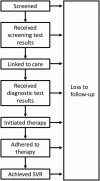Projected Long-Term Impact of the Coronavirus Disease 2019 (COVID-19) Pandemic on Hepatitis C Outcomes in the United States: A Modeling Study
- PMID: 34499124
- PMCID: PMC8522427
- DOI: 10.1093/cid/ciab779
Projected Long-Term Impact of the Coronavirus Disease 2019 (COVID-19) Pandemic on Hepatitis C Outcomes in the United States: A Modeling Study
Abstract
Background: The coronavirus disease 2019 (COVID-19) pandemic disrupted access to and uptake of hepatitis C virus (HCV) care services in the United States. It is unknown how substantially the pandemic will impact long-term HCV-related outcomes.
Methods: We used a microsimulation to estimate the 10-year impact of COVID-19 disruptions in healthcare delivery on HCV outcomes including identified infections, linkage to care, treatment initiation and completion, cirrhosis, and liver-related death. We modeled hypothetical scenarios consisting of an 18-month pandemic-related disruption in HCV care starting in March 2020 followed by varying returns to pre-pandemic rates of screening, linkage, and treatment through March 2030 and compared them to a counterfactual scenario in which there was no COVID-19 pandemic or disruptions in care. We also performed alternate scenario analyses in which the pandemic disruption lasted for 12 and 24 months.
Results: Compared to the "no pandemic" scenario, in the scenario in which there is no return to pre-pandemic levels of HCV care delivery, we estimate 1060 fewer identified cases, 21 additional cases of cirrhosis, and 16 additional liver-related deaths per 100 000 people. Only 3% of identified cases initiate treatment and <1% achieve sustained virologic response (SVR). Compared to "no pandemic," the best-case scenario in which an 18-month care disruption is followed by a return to pre-pandemic levels, we estimated a smaller proportion of infections identified and achieving SVR.
Conclusions: A recommitment to the HCV epidemic in the United States that involves additional resources coupled with aggressive efforts to screen, link, and treat people with HCV is needed to overcome the COVID-19-related disruptions.
Keywords: COVID-19; coronavirus; elimination; hepatitis C; modeling.
© The Author(s) 2021. Published by Oxford University Press for the Infectious Diseases Society of America. All rights reserved. For permissions, e-mail: journals.permissions@oup.com.
Figures



References
Publication types
MeSH terms
Substances
Grants and funding
LinkOut - more resources
Full Text Sources
Medical

